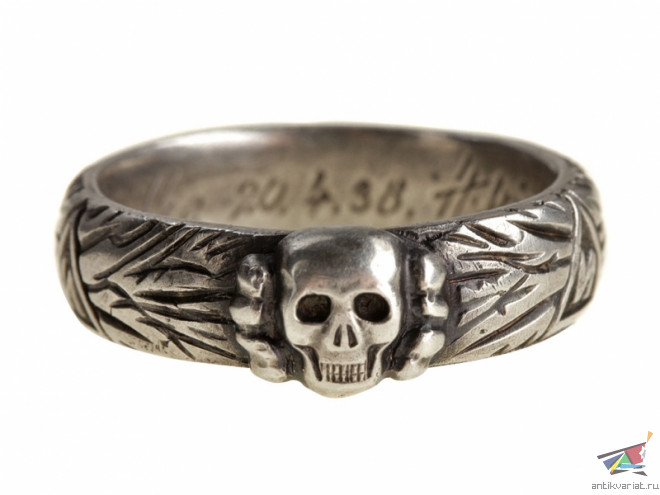The Totenkopfring (SS-Ehrenring) is a personal award given by Heinrich Himmler to members of the SS.
Originally, the ring was awarded to senior officers of the “Old Guard” (of whom there were fewer than 5,000) who demonstrated outstanding courage and leadership in battle. But in the future the rules for obtaining the ring were simplified, and by 1939 almost every SS officer who served more than 3 years could have such an award. SS Abschnitte headquarters regularly submitted lists of awardees, supplemented by finger sizes. The SS Personalhauptmant (SS Personnel Department) reviewed the lists and sent out rings with award slips. A clean list of disciplinary penalties was required as an additional condition.
The rings were manufactured by Gahr & Co. in Munich. On 17 October 1944, the production of rings was halted due to the country‘s economic hardship, but by that time 14,500 rings had been produced.
The ring was cast from a silver plate, then it was bent and the skull was soldered to it. Already finished ring underwent manual jewelry processing. In different years there were different stampings of the skull, slightly different from each other.
He wore a ring on the unnamed finger of his left hand with his skull facing him. It was usually presented in conjunction with the assignment of the next title.
The rings were made of silver. The runes on the ring reflect Himmler‘s interest in mythology and occultism:
The skull (Totenkopf) is a popular SS symbol, long used in the armies of Germany and Prussia.
The swastika for the Nazis meant a symbol of the power of the Aryan race.
Two owl runes symbolize victory.
Runa Hagalaz embodies faith and fellowship, as advocated by the leaders of the organization.
On the inside of the ring were engraved the name of the owner (initials), surname (in full), date of delivery, facsimile of Himmler‘s signature and the abbreviation S Lb. “Seinem Lieben” (his favorite). Along with the ring, a special box for its storage was presented, decorated with SS runes.
The text of the award list
“I award you with the SS “Dead Head” ring. This ring symbolizes loyalty to the Führer, our unswerving obedience and our brotherhood and friendship. The Dead Head reminds us that we must always be ready to give our lives for the good of the German people. The runes opposite the Dead Head symbolize our glorious past, which will be restored through National Socialism. The zig-runes symbolize the abbreviation SS. The swastika and the hagall-rune signify our unbending belief in the inevitable victory of our philosophy. The ring encompasses an oak wreath, oak — a traditional German tree. The Dead Head ring cannot be bought or sold. This ring should never fall into the hands of anyone who has no right to hold it. If you leave the ring If the SS or die, the ring must be returned to the Reichsführer SS. Illegal acquisition or copying of the ring is strictly forbidden and prosecuted by law. Wear this ring with honor!”
In the event of the owner‘s death or his departure from the SS, the ring was to be handed over to Himmler for return to Weelsburg Castle as a memorial to the owner. If the owner of the ring was killed in battle, his companions had to make every effort to retrieve the ring and prevent it from falling into enemy hands. The rings of the killed SS officers were used in the exposition of the Schrein des Inhabers des Totenkopfringes (Tomb of the Holders of the Dead Head Ring) at Weelsburg Castle. By January 1945, 64% of the 14,500 rings had been returned to Himmler. In the spring of 1945, all the rings stored in Weelsburg were searched on Himmler‘s instructions. They haven‘t been found yet.
The elitism and mystical halo of the ring have caused and continue to cause interest. In the Third Reich, the “Dead Head” ring was considered the most prestigious award (although, strictly speaking, it was not a state award such as an order or a personal coat of arms, but a gift from Himmler).
Nowadays, finding the original ring is quite difficult. Since there are very few genuine rings, each confirmed original causes a stir among collectors of military antiques, and sells fairly quickly. A full examination of the ring is lengthy, and includes a thorough verification of whether the size of the ring and the shape of the skull correspond to the confirmed originals of the same period as the date on the ring, a request to the SS archives to verify the authenticity of the award, and a structural analysis of the metal for age. However, 80% of counterfeits are fairly low-quality copies, and they are fairly easy to check. Some of the most common signs of counterfeiting:
*Surname Muller, Lohmann, Deininger, Weber on the inscription. Indicates, as a rule, the “Polish” origin of the counterfeit.
*The ring is made of gold or gilded. The original rings were only made of silver.
*Lack of a straight vertical stripe on the inside of the ring – technological seam – directly behind the skull. Such a seam was always on the originals, which was a consequence of the production technology.
*The presence on the inside of the ring, in addition to the inscription, any other symbols, such as the SS emblem.

